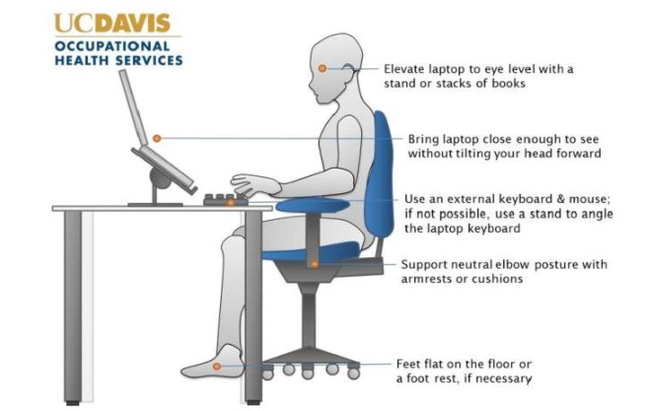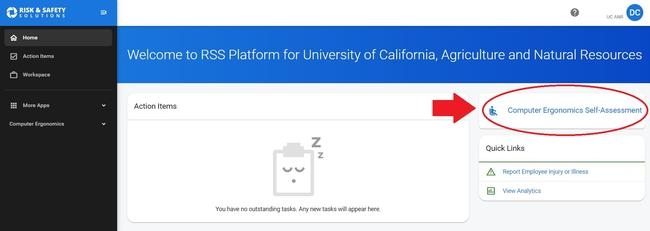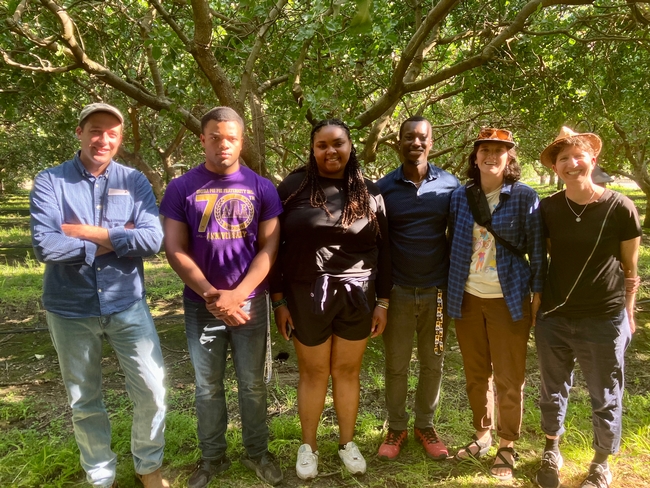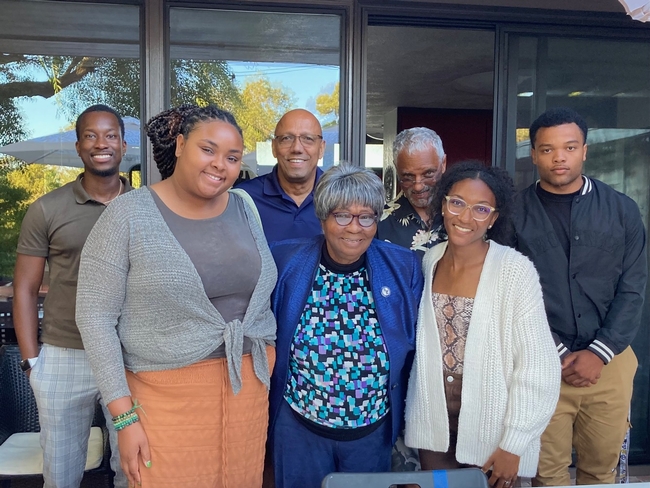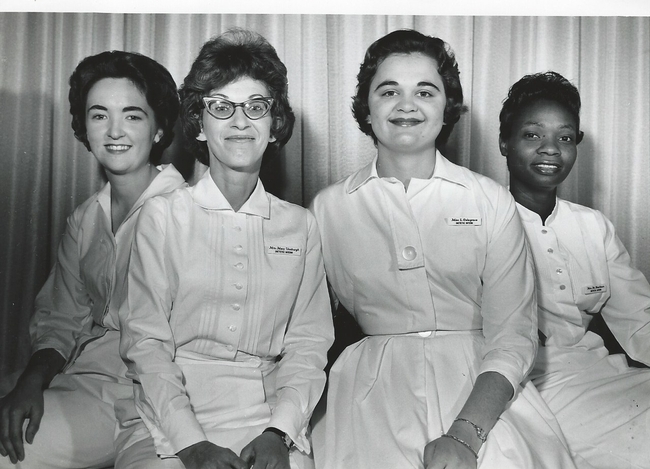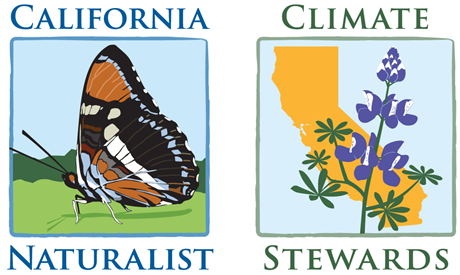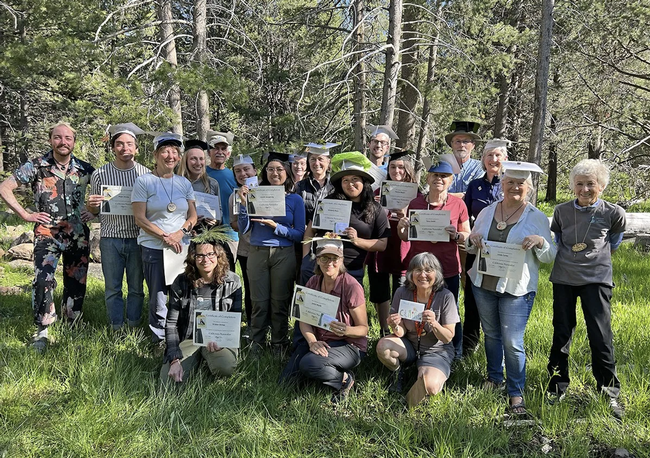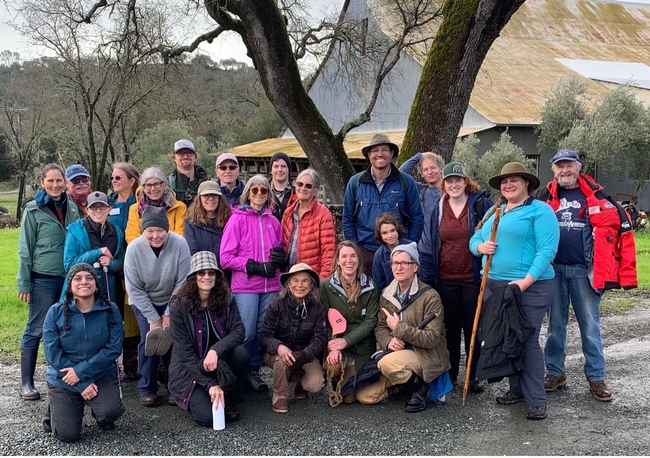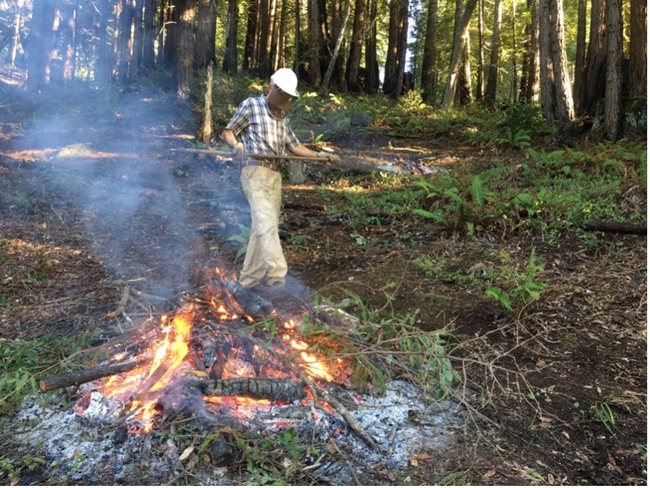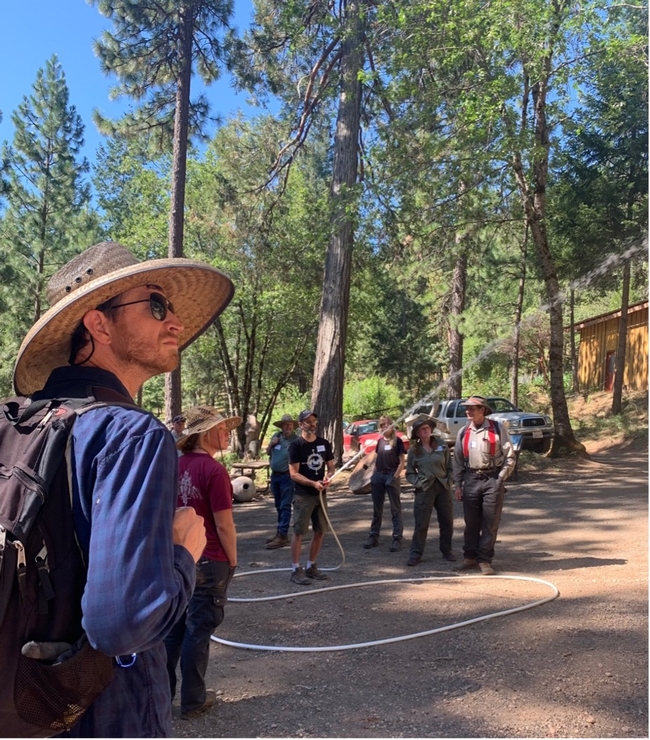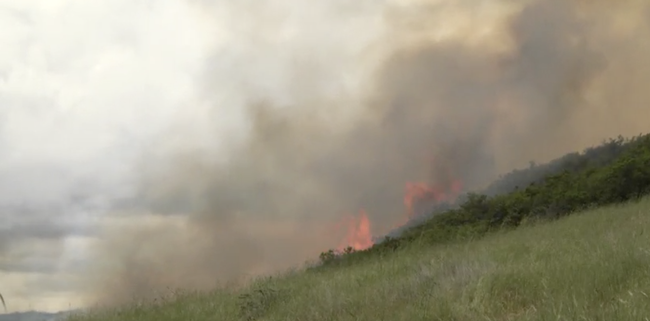Posts Tagged: environmental
New online ergonomic self-assessment tool available
A new online ergonomic assessment tool is now available to ANR staff from Risk & Safety Solutions.
The online self-assessment tool evaluates each employee's workstation ergonomics and provides virtual guidelines on improvements that could be made. Using the information from the online assessment, ANR Environmental Health & Safety specialists can provide an ergonomic evaluation as well, both in-person and remotely.
To access the module, go to https://app.riskandsafety.com. Please use your UC ANR email/login credentials for access.
After you log in, you'll see the tool on the upper right corner of the main page. Once you complete the Ergonomic Assessment Training, it will lead you to the questionnaires about your workstation situation.
As you answer the questions, you will notice that it will provide feedback with some answer choices. Do not correct your answers. To conduct ergonomic adjustments and evaluations as well as apply for the Be Smart About Safety funding for ergonomic support purchases, EH&S will need the full details of your assessment report.
When employees complete the self-assessment, Duwon Choi, UC ANR Environmental Health and Safety specialist, will contact them to discuss their concerns and provide ergonomic adjustment and evaluation if needed.
For further instruction on navigating the self-assessment tool, please go to https://safety.ucanr.edu/Programs/Ergonomics/Ergonomic_Assessment.
‘It’s okay to be different,’ Lewis advises Black environmental scholars
Undergraduates from Historically Black Colleges and Universities visit UC for summer session
Na'Zyia Dowdy-Arnold and Destinee S. Whitaker, both of Spelman College, Christopher Bass of Morehouse College, and Carlos Jackson of Tuskegee University spent the summer getting research experience with UC Berkeley scientists. The four undergraduates from Historically Black Colleges and Universities were participating in the UC Berkeley Department of Environmental Science, Policy and Management HBCU Environmental Scholars Program.
“The program aims to facilitate two-way learning while fostering preparedness and belonging for HBCU students interested in graduate school at UC Berkeley,” said co-founder Rosalie Zdzienicka Fanshel, UC Berkeley doctoral candidate.
Now in its second year, the program, was co-founded by UC Berkeley professor Tim Bowles who also co-directs the program with Fanshel in cooperation with Tuskegee University and Spelman College faculty members.
“After two years as a mentor in the ESPM/UCB HBCU summer research immersion program, I was thrilled to witness the transformation of students,” said Vernard Lewis, emeritus UC Cooperative Extension entomology specialist. “This transformation included doing high-level science and increasing the feeling of belonging. The current cohort of four HBCU students have immersed themselves in lab and field sciences that include campus and ANR units. The hope is to expand the program and to increase the talent pool of HBCU students for graduate programs and careers at UC and ANR.”
During their two-month program, the students toured the San Joaquin Valley with Fanshel and Kristin Dobbin, UCCE water justice policy and planning specialist at UC Berkeley. They visited Allensworth, a utopian agricultural community focused on self-reliance in Tulare County founded in 1908 by African Americans, and UC Kearney Agricultural Research and Extension Center in Parlier, where they met Houston Wilson, UCCE entomology specialist.
Near the end of their stay, Lewis and his wife, Lisa Kala, who held administrative, research and teaching positions in UC Berkeley's Graduate School of Education for over 40 years, hosted a backyard barbecue at their Hayward home for the students to meet Black UC faculty, administrators and alumni.
Lewis assembled African American friends Mary Blackburn, Gloria Burkhalter, Bill Stevens, Bilal Shabazz and his daughter Amani, Fred Logan, Ben Tucker, Elize Brown, Gregory Bradley, Vincent Duncan, Maria Shalita, Carol Chambers-Blockton, Jariel Arvin, Frank McPherson and Charles Clary – some retired and others still enjoying long careers – to meet the young scholars on July 24. Harry LeGrande, emeritus UC Berkeley vice chancellor of student affairs who served in higher education for 45 years, joined the group by Zoom.
McPherson, who retired from UC ANR as UCCE director for the Bay Area in February, cooked up hot links, seafood gumbo and black-eyed peas, served with salad and fresh fruit for the occasion.
“It's okay to be different,” Lewis, the first Black entomologist hired at UC Berkeley, told the students. “You're not alone. We're all with you,” he added, gesturing to the older guests, who had described their professional journeys and how they navigated sometimes unfriendly environments. Some had graduated from college amid the civil rights movement of the 1960s.
Blackburn recalled being offered one of four coveted spots in UC Berkeley's new Master of Public Health Nutrition – Dietetic Internship program after graduating from Tuskegee University in 1963. It didn't seem feasible to move since her husband owned his business in Atlanta and they had four young children. But when the Tuskegee University president said she had to go, Blackburn understood that opportunity was not just about her and three days later she boarded a plane to California. In 1968, Blackburn became one of the first Registered Dietitians in the U.S. and completed her Ph.D. in human nutrition and health planning and administration at UC Berkeley in 1974.
“Find your allies; find your advocates,” Blackburn, UC Cooperative Extension's community nutrition and health advisor for Alameda County for the past 33 years, advised the students.
After the barbecue, the students began collecting email addresses and making connections with their new allies on LinkedIn.
“During our feedback sessions with the students, they expressed their appreciation to all those in attendance, especially Vernard Lewis, who orchestrated the event,” said McPherson. “One of the most important takeaways from the event was their desire to have this type of event with accomplished Black administrators and professionals continue to be part of the programming while at Berkeley.
“They also suggest that these events take place earlier, so that they might take advantage of the knowledge and experience these Black professionals bring to the table, not only as they return to their individual institutions and career paths, but also have access to this network while in the Bay Area.”
A week earlier, during a lunch with Blackburn and Lewis, the students had said they appreciated meeting the two accomplished Black scientists and wished they could meet more. That comment spurred Lewis and Blackburn to organize the barbecue. Despite the short notice, several of their Black colleagues attended. “They showed up because they care,” Lewis said.
They will continue to modify the program based on feedback from the students.
The first year of the program was funded by UC Berkeley's Berkeley Food Institute and Spelman College. The second year was funded by the UC Berkeley Office of Graduate Diversity; Department of Environmental Science, Policy, and Management; and donations from other campus programs and individuals. Each student receives a $5,000 stipend, room and board and travel.
Bowles and Fanshel have applied for a UC-HBCU initiative grant from UC Office of the President to continue the program for another three years.
‘UC Environmental Stewards’ is new home of California Naturalist and Climate Stewards
In 2012, the California Naturalist certification course became a statewide program within UC Agriculture and Natural Resources known as the California Naturalist Program. For 10 years, the course and the program have shared the same name. In 2020, we added the new Climate Stewards certification course. Both courses use education and service to inspire and empower individuals to create more sustainable and resilient communities and ecosystems.
Unfortunately, our program name only reflected one half of our work. To better reflect the scope of both the California Naturalist and the Climate Stewards certification courses, we've renamed our program “UC Environmental Stewards.” This new program name reflects the overarching importance of environmental stewardship to both courses.
While the program name is new, the two courses remain unchanged. The California Naturalist course still proudly focuses on California's natural history under the emblem of the California sister butterfly, and the Climate Stewards course still builds community resilience under the emblem of the lupine. Anyone certified as a California Naturalist or Climate Steward is still a California Naturalist or Climate Steward. UC Environmental Stewards is simply the new programmatic home for these two courses, and potentially any others we may add in the future.
Along with our program name, we are excited to announce additions to our small but growing program team. Jill Santos joins the program in Ventura County at the end of the month and next month we welcome Michelle Peeters, who will support our partners in Northern California.
The growth of the Environmental Stewards program reflects the demand for our courses and the growing need for community and ecosystem resilience. As Californians search for ways to productively engage in local solutions to the challenges of climate change and biodiversity loss, they are finding our courses. Through community education, civic engagement, and the cultivation of a shared identity as environmental stewards, the program builds the adaptive capacity of individuals and communities to address the impacts we are already experiencing, as well as those yet to come.
Our collective impact network of 67 local partner organizations has conducted 422 California Naturalist and Climate Stewards courses and trained over 7,600 participants since the program started. These certified naturalists and stewards have gone on to volunteer over 240,000 hours of service across the state since 2018, worth over $6 million. The UC Environmental Stewards program continues the legacy of the original program started in 2012, and opens the door for many more Californians to effectively engage in discovery, action and stewardship.
Forest research and outreach compiles forestry voices in new story map project
For the past four years, Kim Ingram has been listening closely to the private forest landowners who participate in her Forest Stewardship Workshop series. During the workshops, landowners share their experiences clearing thickets of vegetation, replanting post-wildfire and tackling invasive species, and their concerns of who will take care of their forest when they're gone.
To alleviate their stress, Ingram–Forest Stewardship Education coordinator with University of California Agriculture and Natural Resources–turns to natural resource professionals from CAL FIRE, local Resource Conservation Districts, and the U.S Forest Service who can share knowledge and resources with participants. Recently, Ingram developed a story map that aims to provide landowners with a platform they can use to share their experiences and ways that they have been empowered to manage their land.
"It's not uncommon for small forest landowners to feel overwhelmed with their forest management responsibilities and uncertain over what steps to take first," said Ingram. "Through the Forest Stewardship Workshops and this story map project, we hope to show that there is an entire community of forest landowners in the same situation, learning from each other and moving forward towards their management goals."
The Forest Stewardship Story Map team used ArcGIS StoryMaps to design the project, with 15 participants providing interviews and visual content. StoryMaps provides a user-friendly interface where website visitors can either click on a county to view specific interviews or scroll to view the stories.
The forestry team plans to interview at least one landowner and natural resource professional in every forested county in California so private forest landowners have a local contact or can become inspired by a project in their area.
Theresa Ciafardoni, a forest landowner in Nevada County, said that the UC ANR Forest Stewardship Workshop helped her manage postfire restoration and long-term land use planning.
"It opened up so many options and possibilities," said Ciafardoni. "All the individuals who presented in the Forest Stewardship Workshop were open to phone calls for specific questions and provided invaluable technical assistance."
Involving landowners and forestry professionals with this project was an early decision made by Ingram, who believed it was important that the map held appeal beyond hosting stories. Now, the project functions as a networking tool for landowners seeking professional assistance, too.
Past Forest Stewardship Workshop presenters shared their contact information and the motivations behind their forest management work so that landowners could find assistance in their area. The professionals currently hosted on the map include Resource Conservation District managers, UC ANR forestry advisors and private contractors.
"The most motivated landowners are invested not only economically, but their heart is into it," said Ryan Tompkins, UC Cooperative Extension forestry advisor for Plumas, Sierra and Lassen counties. "The natural world is full of uncertainty, but they're committed to continuing education and learning about how to be a good land steward. This takes a certain level of humility recognizing that our tenure as a steward on the land is a very short period of a forest's lifetime."
Looking ahead, the team envisions the map as a working document that will eventually include interviews with indigenous tribal members who focus on traditional ecological knowledge projects, interviews and information from the UC ANR Postfire Forest Resilience Program, and a feature that will filter stories by topic (e.g. reforestation or prescribed burning).
"This isn't a project that could be completed by one person," explained Grace Dean, Forest Stewardship communications specialist. "The same way that Kim and other presenters explain forest management as a collaborative process holds true for this project."
The Forest Stewardship Workshop series gives participants the ability to start as beginners and build upon their knowledge and experiences. In the same vein, this story map provides the Forest Stewardship team a solid base of real stories to add on to over time. The hope is that it will grow into a multifaceted tool reaching new forest landowners, eventually enveloping their stories within the small forest landowner community.
To view the Forest Stewardship Story Map, visit: https://storymaps.arcgis.com/stories/bd062108d9894da7920d7aef06fe2c2c.
Environmental health science research funding available
The UC Davis Environmental Health Sciences Center invites UC ANR scientists to apply for research funds.
Environmental health science is a branch of public health that is focused on environmental determinants of health.
“This funding is intended to support researchers who are new to EHS to get preliminary data that they can use to pursue larger funding opportunities,” said Shosha Capps, associate director for community engagement. “We highly encourage a community-engaged approach, and part of my job is to support researchers to form effective partnerships with communities in the Central Valley that are impacted by their work.”
“A lot of the topic areas we fund research in are also of interest to folks at ANR, including pesticide use (from a human health perspective), air quality, and water quality and quantity,” said Capps, formerly of the UC Sustainable Agricultural Research and Education Program. “Plus ANR affiliates are already going to be oriented toward applied research and working directly with the communities impacted by their research.”
A list of this year's community research priorities, as well as projects funded in the past, is at https://environmentalhealth.ucdavis.edu/scientists/funding-opportunities/pilot-projects-program.
“A lot of them are in the fields of toxicology, exposure science and epidemiology, but EHS is a multidisciplinary field and we're hoping to reach beyond the usual disciplines this year,” Capps said.
She encourages UC ANR academics to apply with a partner; for example, collaborating with a health researcher to look at the impacts of environmental issues on the health and well-being of farmworkers, farmers or rural communities.
“If someone at ANR works with a community partner who has brought these kinds of issues up as priorities, but they feel it's beyond their expertise, they could refer the community partner to me, and I could try to match them to an appropriate EHS researcher,” Capps said.
For more information, contact Capps at sacapps@ucdavis.edu or (864) 952-9210.

